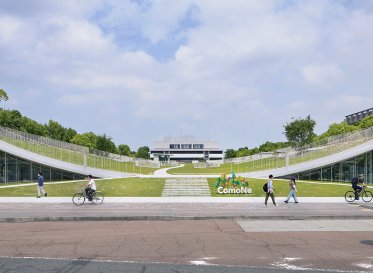
The future as the starting point: reshaping new business development through ‘the circular economy’
Outline
What does the future look like – and what role does one wish to play in it?
It’s a relevant question for not only individuals today, but also companies exploring new business opportunities and development.
For BANDO Chemical Corporation, a pioneer in rubber and elastomer product manufacturing with 110 years under its belt, it was the perfect starting point in their efforts to think outside the box, as they scope out future business development. Having already pinpointed medical equipment and electronic materials as its main business in the future, the company worked with Loftwork to build the future expectations for BANDO Chemical.
With the future of the environment in mind, BANDO Chemical and Loftwork looked to the relatively recent phenomenon of ‘the circular economy’, an economic system based around the elimination of waste and the continual use of resources. Reorienting future business development around the concept, BANDO Chemical was able to not only find a new direction, but also inspired, new ways of thinking.
Project Summary
- Project period: May 2020 – September 2020
- Project System
Client: BANDO CHEMICAL CO.
PM:Masato Uenosono
Researcher:Shinya Kunihiro
Creative Director:Yuko Hattori
Producers:Kazuto Kojima, Sawako Tane
Collaborators: - TEAM CLAPTON (出島實驗品製作)
TEAM CLAPTON - MAP Design
NATSUKI HOSOKAWA DESIGN - Research Collaborators:
Kaori Akiyama(STUDIO BYCOLOR)
Keiko Iwasaki(イワサキケイコキカク)
Yosuke Okita / Michio Yokoyama/ Masahiko Inoue(elements)
Kei Takahashi(COL.architects)
Katsunobu Yoshida(YOSHIKATSU)
Ryohei Yoshiyuki(吉行良平と仕事)
Process
Phase 0: ‘Backcasting’ to build the ideal future of BANDO Chemical
When development is only preoccupied with the technical aspects, the existing framework becomes more difficult to break out of. In order to step out of the box and radically change the way we think, we moved the starting point to the future, and in particular, the needs of future societies. To do so, we took on the ‘backcasting method’, a planning method that starts with defining the ideal future, before backtracking to identify the policies and programs that could take us from ‘now’ to ‘then’.
How will the world change in a few decades? What kind of company does BANDO Chemical expect itself to be? And, is that vision truly good for the world?
Delving into these big questions, Loftwork helped BANDO Chemical to re-examine not only the wider context, but also itself – subsequently arriving at the conclusion of ‘environmentally friendly manufacturing’ as a primary focus for future technology development, something that was also in line with the company’s mission.

Phase 1: Reorienting the direction of future development through the lens of the circular economy
In order to shift future technology development towards ‘environmentally friendly manufacturing’, we embarked on relevant research in Phase 1 to further understand ‘the circular economy’.
Collecting more than 120 cases of circular economy in the global manufacturing industry, we interviewed experts and scholars in related fields and tried to identify the elements required to create such a system. Then, we created a circular economy map to visualize the role new technologies can play in the circular economy as a whole.
In the process of data collection and integration, we were able to see that new technologies could not only fit into the future of the circular economy, but provided opportunities for new business. For the next phase, we would further explore where new technologies could fit into the concept, and subsequently determine the future direction of development.
111 examples of circular economy (link in Japanese)
Phase 2: Identifying new uses for new technologies through the creative perspectives
To identify the potential uses for new technologies in a circular economy society, we experimented by working with six creators of different backgrounds (material designers, market researchers, architects, etc.) to create prototypes. In addition to the final prototypes themselves, the discoveries and opinions of the creators during the process also proved to be a valuable source of perspective and inspiration for future development.
In this experiment, each creator selected the material based on their respective points of view, which was then tested in the lab as per their instructions. Providing creators with feedback on the findings immediately after, we then discussed the materials to use for the next attempt, ways to adjust the shape or form, and repeated the process based on the results.
Prototyping with the six creators not only instilled inspiration on ways to develop new technologies into new business, but also gave us a clearer vision on how to apply new technologies in our future lives.


New prototyping methods for co-creation in the pandemic era
Given the current pandemic conditions and social distancing measures, we also sought to find new ways to conduct research and collaborative projects. In addition to communicating online, we also designed a production process to deliver prototypes and materials via boxes. Rather than relying only on meetings to move the project forward, we made it possible to collaborate with the creators in a safe, distanced way.


Collaborators






Breaking through established concepts and frameworks for new co-creation
One of the major goals for this project was to break through the rigidity of existing ideas and redefine the value of new technologies through an ‘outside perspective’.
During the research process, we often had to work together to complete tasks, such as editing a document for a desktop study, and reorganizing the complex information collected into clearly structured diagrams during overnight training sessions.
Through this arrangement, the barriers of clients and employees are broken down bit by bit so that everyone can unite as a real team and work together on a single project. After experiencing the process and the results, the members can truly identify with the new values that are unearthed at the end. The new discoveries and techniques we learned during the process can be reapplied to our future business development work, making this project a very fruitful learning opportunity.
Outputs
Circular Economy Roadmap

Professor Yasushi Umeda (Research Professor, Department of Engineering, The University of Tokyo), who assisted in the interviews with experts and scholars in this project, praised the roadmap: “I have never seen a map that gives such a clear picture of circular economy through qualitative and narrative content, which is excellent.”
Download the roadmap
The Circular Economy Map is licensed under the Creative Commons Attribution-Non-Commercial-Share-Alike License (CC BY-NC-SA 4.0*): This license allows users to reproduce, distribute, transmit, and modify the work, but not to use it for commercial purposes. If the user modifies the work, the derivative work must be distributed in the manner specified by the licensor, and the new work produced must be released under the same license. For commercial use, please contact Loftwork PR (pr@loftwork.com)


The experiment was conducted in a rented factory, commonly known as 出島實驗室. In just two days, with help from TEAMclapton, we renovated the interior space, transforming it into a working environment that would raise morale amongst the members, keeping them in a state of ‘anticipation’ for the development work. In addition, the lab was equipped with a display area for test samples and a storage space under the floor, greatly improving the functionality of the lab.
Service
Beyond business development consulting: Innovation for material manufacturers
Created by Loftwork, MTRL is a material design and innovation lab for both creators and manufacturers. MTRL works with a variety of materials, ranging from the common to the cutting-edge, and has supported companies, research institutes and local governments in product development, the development of new applications, as well as branding for new markets.
For the manufacturing industry today, ‘innovation’ no longer stops at the product level; it is something embedded in the core business strategies of companies.
We invite businesses interested in applying innovative thinking to discover with us the changes in the industry ecosystem and the evolution of new materials at the application level, so that we can achieve more meaningful ‘innovation’ together.
Click here for our business plans for material manufacturers
Next Contents











